Open only to WEAD listing artists and members, each Portfolio is curated by the Editorial Committee to showcase artists whose work reflects diverse approaches to environmental and social justice art.
ARTISTS
ANGELA GONZALEZ
CAROL LAMBERT
FABIOLA MARTINEZ
PAULA ORTEGA
ROBIN LASSER AND ADRIENNE PAO
R. R. PASCOE
BONNIE PETERSON
LISA REINDORF
GUADALUPE DEL VALLE
ANGELA GONZALEZ

7.4 GIG, Mixed media on wood, 44 inches diameter.
Our planet faces an unprecedented environmental crisis caused by global warming, intensive farming, and habitat destruction. A sustainable future requires a balance between people, planet and profit. Keeping this balance represents a challenge in a world of hyper population and aggressive business practices.
I create artworks to generate awareness about the environment and to help the viewer make the connection between art, technology and sustainability.
CAROL LAMBERT
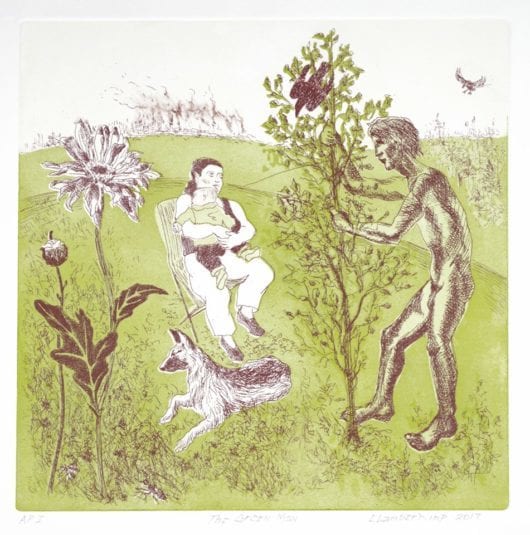
THE GREEN MAN, intaglio etching, 12″ x 11.75″.
Using intaglio printmaking, I show women relying on their physicality, strength, courage, and dignity to confront absurd or dangerous circumstances. These include physical, emotional, and environmental threats. My protagonists, though vulnerable and not always heroic, are self-possessed and aware. I intend to engage viewers’ curiosity and invite identification, not only with the characters, but with the visceral effects of their situations. I draw on familiar elements of popular and historic genres. Sometimes genteel on the surface, my images address women’s struggles, identity, development, coping, and determination. I often employ satire and/or visual humor. I am inspired by feminism, surrealism, classical mythology, and early 20th century comics.
FABIOLA MARTINEZ
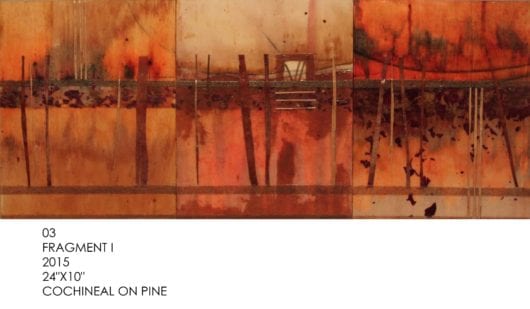
I am Saint John based artist born in Mexico with degree in architecture from the Institute Tecnológico de Querétaro.
I am interested in natural resources and the preservation of ancestral techniques.
In the last year I have been exploring the use of a natural dye Cochineal (Dactylopius coccus) derived from ‘carmine’, a pigment produced by a female insect that grows on a cactus in South America. Creating a series of abstract compositions using fibers and sand with Cochineal on pine, canvas and maple wood.
PAULA ORTEGA
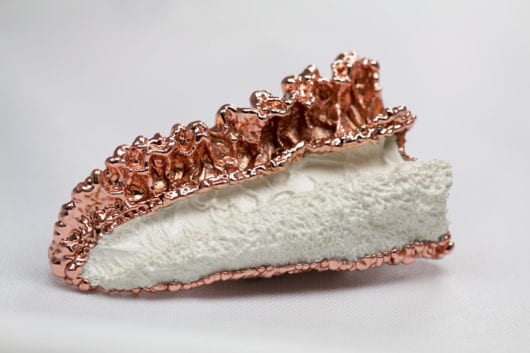
FOOTPRINT ONE, Studio-made casein bioplastic and electroformed copper, 2015.
Paula Ortega is an Anglo-Argentinean artist concerned with what constitutes the objects we use and admire, their origin and the trace they eventually leave, whilst challenging our perception of their value. A trained opera singer, she also received a BA in audio-visual communication before training in jewellery making in London.
Paula Ortega’s work asks both philosophical and environmental questions. Relentlessly curious, she has developed her own bioplastic using casein, a protein present in milk. Her Footprints series explores the ideas behind the lifespan of a work of art.
The pieces are a mesh of a fantastical fossil and a microscopic organism; sparkling metal and gleaming white casein. The ephemerality of these works mean that eventually the plastic will biodegrade, leaving behind a metal carcass to be enjoyed, or to be melted and reused elsewhere.
ROBIN LASSER AND ADRIENNE PAO
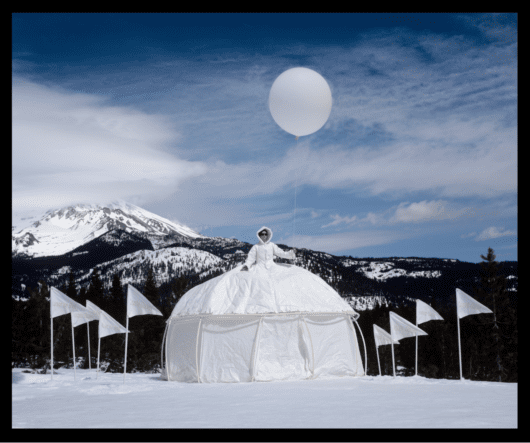
The Ice Queen: Glacial Retreat Dress Tent, photographed at Mt. Shasta, California underneath one of the few advancing glaciers in the world, embodies the look of a sexy weather hazard/ emergency worker in her white winter garb. The dress tent is a polar weather station and research lab, offering a space to ponder the earth, global warming, and glaciers. Underneath her skirt, a chorus of crickets vary their tune, in direct relationship to the climatic changes that have occurred across the globe, from the industrial revolution to the present and beyond. Overlaid upon the cricket chirping are weather reports from the locale in which the tent is stationed, as well as a weather reporter adding commentary on the ice queen’s current temperature and state of mind.
R. R. PASCOE
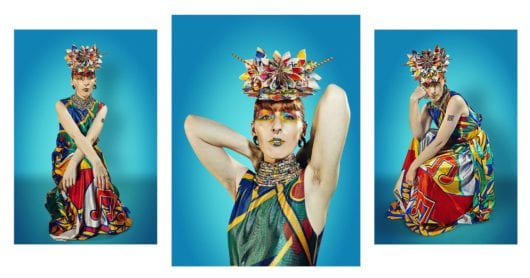
YOUR SHIT IS MY CHANEL, origami junk mail pamphlet paper headpiece and rolled bead neckpiece with salvaged Sydney World Youth Day banner dress, 2016. Photographs by Emma Rowan Kelly and Andre Matkovic, 2015.
R.R. Pascoe is an Australian sustainable designer and artist. Largely self taught, she has been creating wearable artworks from found objects and waste materials for close to two decades. Her use of reclaimed materials in traditionally luxury, high end products aims to draw attention to the environmental and social impacts of the fashion industry, and to question ideas of conventional beauty, notions of obsolescence, and explore the commodification of self and identity.
BONNIE PETERSON
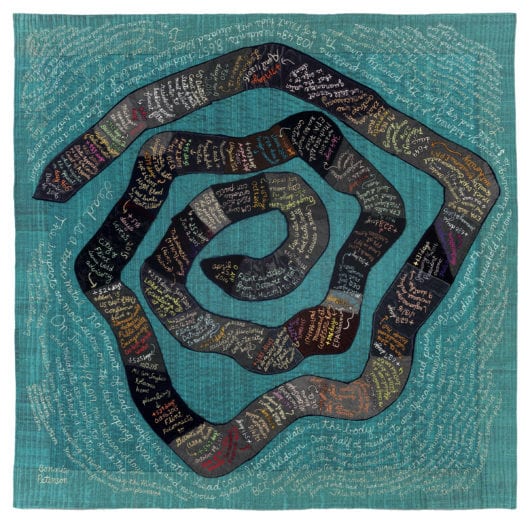
DAYS OF LEAD (Pb), 50′ H x 50′ W, Embroidery on silk and velvet chronicles significant events during the first 1,000 days of toxic.
I use embroidery to investigate cultural and environmental issues. I stitch words and phrases on velvet and silk fabrics to make large narrative wall hangings. My recent projects examine geophysical climate issues.
LISA REINDORF
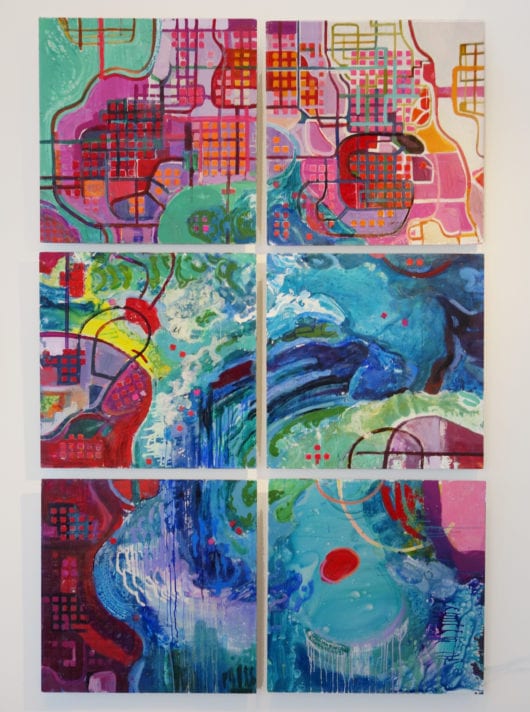
RISING SEAS- A tidal wave overwhelms a coastal city.
Much of my work addresses the obliteration of the natural world to make way for cities—and the destruction in cities by the natural world. There is an inherent conflict between nature and building. Nature has created its own systems, and anytime we build or construct infrastructure, we’re interfering with that. Not only are we adversely impacting the environment, but there is a strong counter reaction. The environment strikes back- with rising seas, coastal flooding and polluted waterways. In this aerial view painting, a gridded city is being submerged by sea surges.
GUADALUPE DEL VALLE
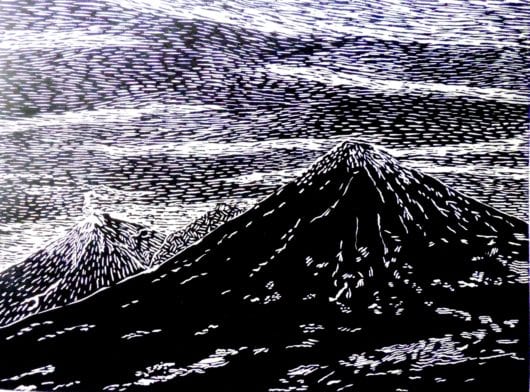
AGUA VOLCANO, Xylography Artist proof. 40 x 50 cm, 2017.
The volcanoes are a shared metaphor for the little we know about our giants, some asleep, most stratovolcanoes like the Santo Tomás volcano, which is a dormant volcano and is part of the volcanic arc of Central America.
Also, these volcanoes erupt to remind us that woodcutting is a language of graphics that nowadays is never used to represent nature, since fashion is large format painting and color, that is why I want to work with it our volcanoes, because it is a tribute to the oldest format of graphic arts whose origin dates back to the year 220 in China and the sixth and seventh centuries in Egypt. My proposal revives an ancient language and presents the fraternity that unites us in the world through the volcanic arc.
